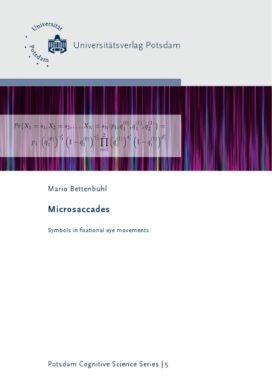The first thing we do upon waking is open our eyes. Rotating them in our eye sockets, we scan our surroundings and collect the information into a picture in our head. Eye movements can be split into saccades and fixational eye movements, which occur when we attempt to fixate our gaze. The latter consists of microsaccades, drift and tremor. Before we even lift our eye lids, eye movements – such as saccades and microsaccades that let the eyes jump from one to another position – have partially been prepared in the brain stem. Saccades and microsaccades are often assumed to be generated by the same mechanisms. But how saccades and microsaccades can be classified according to shape has not yet been reported in a statistical manner. Research has put more effort into the investigations of microsaccades’ properties and generation only since the last decade. Consequently, we are only beginning to understand the dynamic processes governing microsaccadic eye movements. Within this thesis, the dynamics governing the generation of microsaccades is assessed and the development of a model for the underlying processes. Eye movement trajectories from different experiments are used, recorded with a video-based eye tracking technique, and a novel method is proposed for the scale-invariant detection of saccades (events of large amplitude) and microsaccades (events of small amplitude). Using a time-frequency approach, the method is examined with different experiments and validated against simulated data. A shape model is suggested that allows for a simple estimation of saccade- and microsaccade related properties. For sequences of microsaccades, in this thesis a time-dynamic Markov model is proposed, with a memory horizon that changes over time and which can best describe sequences of microsaccades.
Symbols in fixational eye movements
ISBN: 978-3-86956-122-6
130 pages
Release year 2015
Series: Potsdam Cognitive Science Series , 5
14,50 €
Non-taxable transaction according to § 1 (1) UStG/VAT Act in combination with § 2 (3) UStG/VAT Act a. F. Providing this service, the University of Potsdam does not constitute a Betrieb gewerblicher Art/Commercial Institution according to § 1 (1) No. 6 or § 4 KStG/Corporate Tax Act. If the legal characterization of our business is changed to a commercial institution subsequently, we reserve the right to invoice VAT additionally. zzgl. Versandkosten
The first thing we do upon waking is open our eyes. Rotating them in our eye sockets, we scan our surroundings and collect the information into a picture in our head. Eye movements can be split into saccades and fixational eye movements, which occur when we attempt to fixate our gaze. The latter consists of microsaccades, drift and tremor. Before we even lift our eye lids, eye movements – such as saccades and microsaccades that let the eyes jump from one to another position – have partially been prepared in the brain stem. Saccades and microsaccades are often assumed to be generated by the same mechanisms. But how saccades and microsaccades can be classified according to shape has not yet been reported in a statistical manner. Research has put more effort into the investigations of microsaccades’ properties and generation only since the last decade. Consequently, we are only beginning to understand the dynamic processes governing microsaccadic eye movements. Within this thesis, the dynamics governing the generation of microsaccades is assessed and the development of a model for the underlying processes. Eye movement trajectories from different experiments are used, recorded with a video-based eye tracking technique, and a novel method is proposed for the scale-invariant detection of saccades (events of large amplitude) and microsaccades (events of small amplitude). Using a time-frequency approach, the method is examined with different experiments and validated against simulated data. A shape model is suggested that allows for a simple estimation of saccade- and microsaccade related properties. For sequences of microsaccades, in this thesis a time-dynamic Markov model is proposed, with a memory horizon that changes over time and which can best describe sequences of microsaccades.
Recommended Books
-
 2008
2008Wahl, Michael; Hanne, Sandra; Heide, Judith (Hrsg.)
Schwerpunktthema: Der Erwerb von Lexikon und Semantik, Meilensteine, Störungen und Therapie
7,50 €Non-taxable transaction according to § 1 (1) UStG/VAT Act in combination with § 2 (3) UStG/VAT Act a. F. Providing this service, the University of Potsdam does not constitute a Betrieb gewerblicher Art/Commercial Institution according to § 1 (1) No. 6 or § 4 KStG/Corporate Tax Act. If the legal characterization of our business is changed to a commercial institution subsequently, we reserve the right to invoice VAT additionally.
zzgl. Versandkosten
Add to cart -
 2020
2020Claudia Iven, Bernd Hansen, Kristina Anders, Kirsten Richardt, Holger Prüß, Martina El Meskioui, Tobias Haase, Lea Mahlberg, Lea Wiehe, Carola de Beer, Rebekka Niepelt Karampamapa, Andrea Hofmann, Nicole Stadie, Sandra Hanne, Blanca Schäfer, Jenny Thomson, Clara Huttenlauch, Isabell Wartenburger, Katharina Weiland, Anita Bethge, Sophie Brekeller, Anke Buschmann, Nora Fieder, Ulrike Frank, Julia Hartung, Hella Kaps, Annegret Klassert, Anne Kutz, Anna Luisa Mähl, Iman Nousair, Rasha Abdel Rahman, Katja Ryll, Kathleen Schneider, Martin Seefeld, Simone Sprenger, Julia Unger, Jacolien van Rij, Rahel Verbree, Michael Wahl, Caroline Wellmann, Anke Wirsam
Schwerpunktthema: Weg(e) mit dem Stottern
12,50 €Non-taxable transaction according to § 1 (1) UStG/VAT Act in combination with § 2 (3) UStG/VAT Act a. F. Providing this service, the University of Potsdam does not constitute a Betrieb gewerblicher Art/Commercial Institution according to § 1 (1) No. 6 or § 4 KStG/Corporate Tax Act. If the legal characterization of our business is changed to a commercial institution subsequently, we reserve the right to invoice VAT additionally.
zzgl. Versandkosten
Add to cart -
 2013
2013Tom Fritzsche, Anne Adelt, Corinna B. Meyer, Jennifer Roß
Schwerpunktthema: Labyrinth Grammatik
10,50 €Non-taxable transaction according to § 1 (1) UStG/VAT Act in combination with § 2 (3) UStG/VAT Act a. F. Providing this service, the University of Potsdam does not constitute a Betrieb gewerblicher Art/Commercial Institution according to § 1 (1) No. 6 or § 4 KStG/Corporate Tax Act. If the legal characterization of our business is changed to a commercial institution subsequently, we reserve the right to invoice VAT additionally.
zzgl. Versandkosten
Add to cart -
 2015
2015Anne Adelt, Tom Fritzsche, Caroline Magister, Constanze Otto
Schwerpunktthema: Besonders behandeln?
10,00 €Non-taxable transaction according to § 1 (1) UStG/VAT Act in combination with § 2 (3) UStG/VAT Act a. F. Providing this service, the University of Potsdam does not constitute a Betrieb gewerblicher Art/Commercial Institution according to § 1 (1) No. 6 or § 4 KStG/Corporate Tax Act. If the legal characterization of our business is changed to a commercial institution subsequently, we reserve the right to invoice VAT additionally.
zzgl. Versandkosten
Add to cart
Publisher Info
Contact
Potsdam University Library
University Press
Am Neuen Palais 10
14476 Potsdam
Germany
verlag@uni-potsdam.de
0331 977-2094
0331 977-2292





